.jpg)
.jpg)
.jpg)
Painting the Spirit of Tasmania in Garden Island Drydock
Painters and dockers - Artist in Residence on the tall ship 'James Craig' Part 2

.jpg)
.jpg)
.jpg)
 |
Exhibition of paintings of Pyrmont by Jane Bennett at the 2013 Pyrmont Festival
|
 |
Exhibition of paintings of Pyrmont by Jane Bennett at the 2013 Pyrmont Festival
|
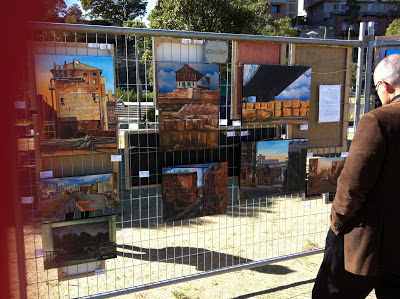 |
Exhibition of paintings of Pyrmont by Jane Bennett at the 2013 Pyrmont Festival contact me |
 |
Exhibition of paintings of Pyrmont by Jane Bennett at the 2013 Pyrmont Festival contact me |
 |
"Decisions, decisions... which one should I buy?"
Exhibition of paintings of Pyrmont by Jane Bennett at the 2013 Pyrmont Festival
|
Related posts
This small canvas is of Miller's Point - the boat, that is - not its namesake suburb up the hill! 
MW14 'Millers Point'
2013 oil on canvas 41 x 31cm
Available for sale
There's quite a motley collection of work vessels big and small, berthed at the Sydney Port Corporation's Port Jackson headquarters at Moore’s Wharf. 
MW14 'Millers Point'
2013 oil on canvas 41 x 31cm
Available for sale
As I arrived, "Millers Point", Sydney Port Corporation’s new emergency
response launch, was being lifted from the water onto piles of huge tyres on the wharf, alongside
the crane.
Usually it's in the water at its customary berth in front of Moore's Wharf, but it was waiting to get its twin 225hp Honda outboard motors serviced.
MW14 'Millers Point'
2013 oil on canvas 41 x 31cm
Available for sale
I hadn't painted this new addition to Sydney Port Corporation's fleet before, & I decided to capture the drama of the boat lift in a small canvas.
I must admit that I was still mourning the loss of the historic old warhorse, the 'Poolya', which had been broken up at Glebe Island Wharf, in early February 2013, not long before.
"Millers Point" was designed in Western Australia by Global Marine and built by Axiom Alloys of Mt Druitt.
"Millers Point", is 9.3m in length with a beam of 3.35m and a draft of 0.55m. It has a speed that can exceed 40kn. It has a trihedral hull & is fitted with a 6hp stand-alone fire pump. 
MW14 'Millers Point'
2013 oil on canvas 41 x 31cm
Available for sale
Related Posts
 |
First version of SHF6 'Sydney Heritage Fleet at Rozelle' 2013
oil on canvas 122 x 183cm
|

 |
Starting a small oil sketch of the "Shirley Smith" on the Goat Island slipway,
oil on canvas 13 x 18cm
|
 |
Starting a small oil sketch of the "Shirley Smith" on the Goat Island slipway,
oil on canvas 13 x 18cm
|
 |
My first small oil sketch of the "Shirley Smith" on the Goat Island slipway, oil on canvas 13 x 18cm |
 |
Another view of my small oil sketch of the "Shirley Smith" on the Goat Island slipway, oil on canvas 13 x 18cm
|
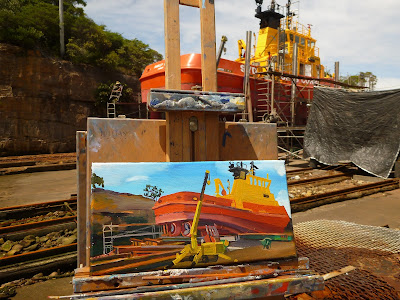 |
Starting my second small oil sketch of the "Shirley Smith" on the Goat Island slipway, oil on canvas 15 x 31cm
|
 |
My 2nd small oil sketch of the "Shirley Smith" on the Goat Island slipway
oil on canvas 15 x 31cm
|
 |
| My Artist's Studio in a suitcase |
 |
| I've had to cable tie the large canvas to my studio easel |
 |
I've had to cable tie the large canvas to my studio easel- and then cable tie the easel to a timber block!
|
I've always loved Turner's paintings and now I feel that I am literally following in his footsteps!
 |
| Timber block and easel |
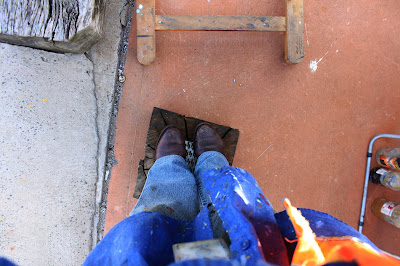 |
| Timber block and easel used by plein air painter Jane Bennett |
 |
| My large plein air painting of Goat Island from Moore's Wharf at about 8am |
 |
| My large plein air painting of Goat Island from Moore's Wharf at about 9am |
 |
| My large plein air painting of Goat Island from Moore's Wharf at about 9.30am |
 |
| My large plein air painting of Goat Island from Moore's Wharf at about 10am |
 |
| My large plein air painting of Goat Island from Moore's Wharf at about 11am |
 |
| My large plein air painting of Goat Island from Moore's Wharf at about noon |
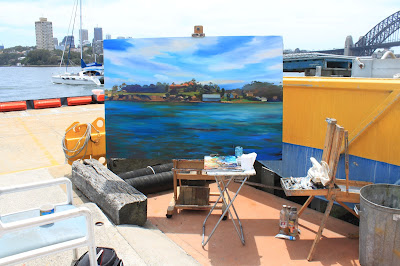 |
| My large plein air painting of Goat Island from Moore's Wharf at about noon |
 | |
The completed canvas
|
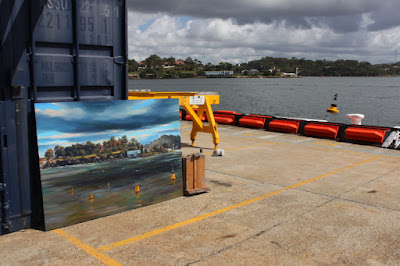 | |
|
 | |
|
.JPG) | |
Enquiries about this painting
And finally a few days later, here it is hanging in my solo exhibition "From the Hungry Mile to Barangaroo" at the Frances Keevil Gallery.
|